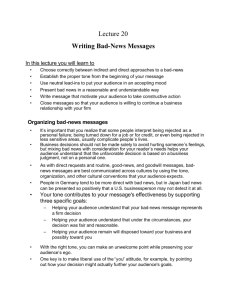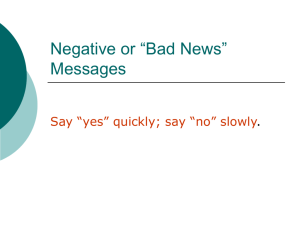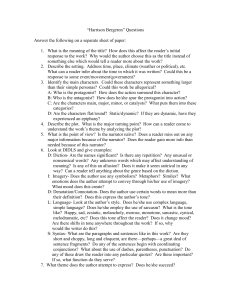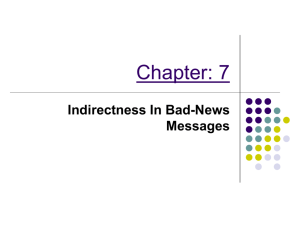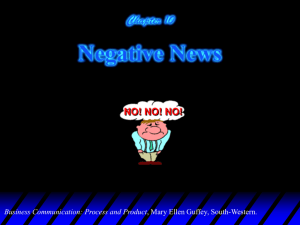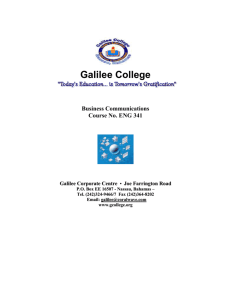Lecture 13 Composing Business Messages
advertisement
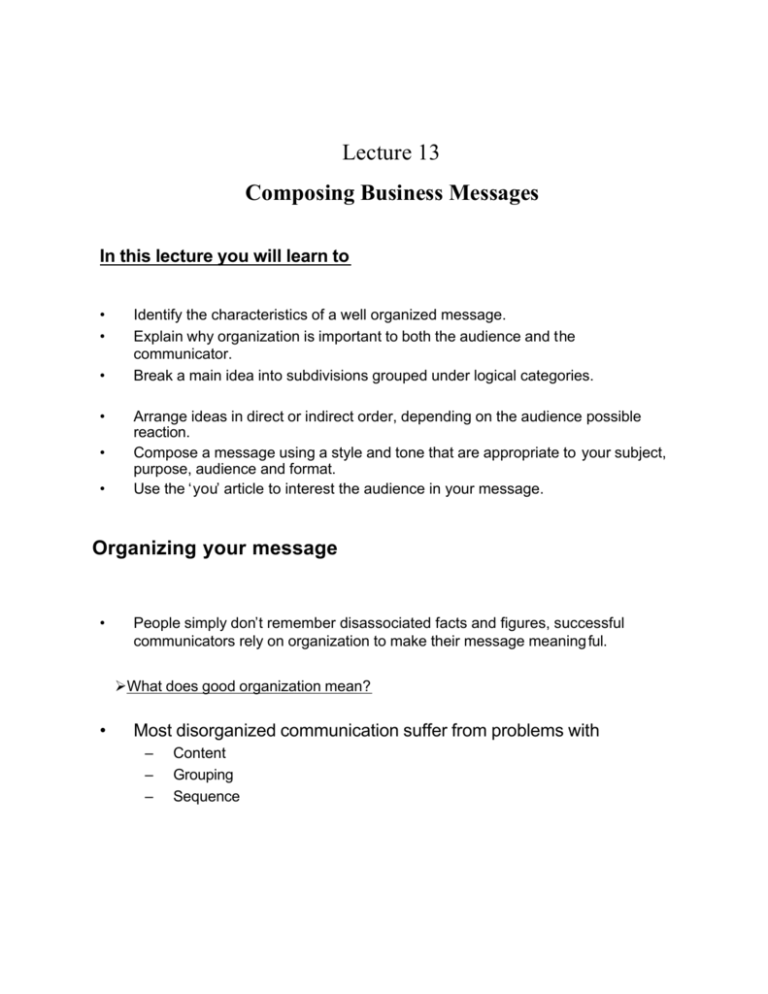
Lecture 13 Composing Business Messages In this lecture you will learn to • • • • • • Identify the characteristics of a well organized message. Explain why organization is important to both the audience and the communicator. Break a main idea into subdivisions grouped under logical categories. Arrange ideas in direct or indirect order, depending on the audience possible reaction. Compose a message using a style and tone that are appropriate to your subject, purpose, audience and format. Use the ‘you’ article to interest the audience in your message. Organizing your message • People simply don’t remember disassociated facts and figures, successful communicators rely on organization to make their message meaning ful. ØWhat does good organization mean? • Most disorganized communication suffer from problems with – – – Content Grouping Sequence Letter Problems • Taking too long to get to the point – The writer of the letter took too long to get to the point. – She waited until the final paragraph to state her purpose. • Including Irrelevant Material – No information should be introduced which has no purpose. • Getting ideas mixed up – The ideas should not be in the wrong place – A sequence should be followed in which ideas are built upon previous ones. • Leaving out necessary Information – – The prime focus should be include the information required by the reader. Leaving out reader’s desired information would be highly undesirable. What Good organization means • • • • The subject and purpose are clear. All information is related to the subject and purpose. The ideas are grouped and presented in a logical way. All necessary information is included. Why Good information is important • Why does it matter to put information in any way and leave it to the reader to grasp the information ? • By arranging the ideas in a logical and diplomatic and way, you will increase the chances of satisfying the audience’s needs. Helping your audience understand the message • • • The main reason for being organized is to improve your chances that people will understand exactly what you mean. Good organization also helps you get your ideas across without upsetting the audience. Good organization helps motivate the audience to accept your message. Saving your Audience’s Time • • Well organized messages are efficient. They only contain relevant information, so the audience does not waste time with superfluous information. Simplifying your Communication Tasks • • Finally being well organized helps you compose your message more quickly and efficiently. before you start to write makes the Organizing what you are going to say job much easier. Letter Computer Time 556 Seventh Avenue, N.W. Mason City, Iowa50401 (515) 979-8870 September 17, 1995 Ms. Jill Sunders Boswell & Sons Route 7, Hancock Highway Clear Lake, IA 50401 Dear Ms. Saunders: Thank you for letting us know about your experience with the Olympic disk drive that your bought last November. It’s important that we learn of unusual problems with the equipment we stock. As you know, regularly priced equipment returned to Comutertime within 30 days is covered by the unconditional refund that has been our tradition for 22 years. Your machine, however, is still covered by the manufacturer’s warranty. Your needs will receive immediate attention if you write to Mr. George Bander Olympic Systems P.O. Box 7761, Terminal Annex Los Angeles, CA 90010 From experience, I know that the people at Olympic truly care about having satisfied customers. We, too, value your business, Ms. Saunders. Please don’t miss our Tax Days sale in April, which will features more of the low prices and high-quality equipment that you’ve come to rely on. Sincerely, Linda Davis Customer Service How good organization is achieved • • To organize a message first group the ideas and then put them in sequence. In business, deciding what to say is more important than deciding how to say it. Define and group Ideas • An outline or a schematic diagram will help you visualize the relationship among the parts of a message. – Start with the main idea – State the major points – Illustrate with evidence Start with the Main Idea • The main idea is the starting point for constructing an outline. – What you want your audience to do or think ? – Why they should do so ? State the Major points • • • The main idea should be supported by three to five major points. The breakdown of the Main idea into major points and major points into evidences is best represented with a organization chart. Chart shown on next slide. Organization Chart Illustrate with Evidence • Each major point should be supported with enough specific evidence to be convincing, but not so much that it becomes boring! Establish Sequence with Organizational Patterns • You have two options after you have defined and grouped your ideas – Direct Approach – Indirect Approach • Direct Approach (deductive) – • Indirect Approach (inductive) – • • • • Putting the main idea first followed by evidence. Putting the main idea first and evidence later. Use direct order if the audience’s reaction is likely to be positive and indirect order if it is likely to be negative. Short messages follow one of four organizational plans, depending on the audience’s probable reaction. Direct requests – Direct requests get straight to the point because the audience usually wants to respond. Routine, Good-News and Goodwill Messages – The direct approach is effective for messages that will please the reader or will cause no particular reaction. Direct Request Format The letter begins with the main idea. The midsection makes a request and provides essential details. In closing the letter refers to the main point and states the desired action. Routine, Good-News and Goodwill Message Format The letter begins with the good news. All necessary details are provided in the middle part. This paragraph gives additional specifics. In closing the letter refers to the main point and states the desired action. Establish Sequence with Organizational Patterns • Bad-News Messages – If you have bad news, try to put it somewhere in the middle, cus hioned by other, more positive ideas. Establish Sequence with Organizational Patterns • Bad-News Messages – If you have bad news, try to put it somewhere in the middle, cus hioned by other, more positive ideas. Bad-News Message Format The letter begins with a neutral statement that provides a transmission to the refusal. The midsection explains the reason for refusal and then states the bad news. The writer takes care to introduce a positive thought. The letter closes on a cordial note. Establish Sequence with Organizational Patterns • Persuasive Messages – Using the indirect approach gives you an opportunity to get your message across to a skeptical or hostile audience. Persuasive Message Format The letter begins with questions to catch the readers attention. The letter leads up to the main point by arousing the reader’s interest. This section gives the reader a motive for complying with the request. The letter closes with an appeal . Establish Sequence with Organizational Patterns • Longer Message – – The organization of a longer message should reflect both the purpose of the message and the audience’s probable reaction. When your purpose is to inform, the major points are based on a natural order implied by the subject’s characteristics. Organizational plan should depend on the reaction you anticipate • Your audience may respond in two ways to your material. – If you expect your audience to agree with you, use a structure that focuses attention on conclusion – If you expect your audience to be skeptical about your conclusions, use a structure that focuses on rational that supports your point of view. Formulating your Message • Your first draft – • Your style and Tone – • • When composing the message vary the style to create a tone that suits the occasion. Think about the relationship you want to establish – – – – – – • Composition is the process of drafting your message; polishing it is a latter step. Don’t be too familiar Use humor only with great care Don’t flatter the other person Don’t preach Don’t brag Be yourself Use the ‘you’ attitude The ‘you’ attitude is best implemented by expressing your message in terms of the audience’s interests and needs. Avoid using the ‘you’ and ‘yours’ – – – To excess When assigning the blame If your organization prefers a more formal style. Example • • • Instead of this – To help us process in this order, we must ask for another copy of the requisition Use this – So that your order can be filled promptly, please send another copy of the requisition. Instead of this – • We prefer typewriter ribbons in three colors: black, blue and green. Use this – Take your pick of type writer ribbons in three colors: black, blue and green. Remember! • The word ‘you’ does not always indicate a ‘you’ attitude, and the ‘you’ attitude can be displayed without using the word ‘you’. Example • Instead of this – • Use this – • That kind of paper doesn’t work very well in the machine. Instead of this – • You should never use that kind of paper in the machine. You need to make sure the staff follows instructions. Use this – The staff may need guidance in the following instructions. Emphasize the positive • • Explain what you have done, what you can do, and what you will do – not what you haven’t done, cant do or wont do. When you are offering criticism or advice, focus on what the person can do to improve. Example • Instead of this – • The problem with this department is a failure to control costs. Use this – The performance of this department can be improved by tightening up cost controls. Establish Credibility • • Don’t make a false promise People are more likely to react positively to your message when they have confidence in you. Example • Instead of this – • We hope this recommendation will be helpful. Use this – We’re glad to make this recommendation. Be Polite • • • Try to express facts in a kind and thoughtful manner. Use extra tact when writing and when communicating with higher-ups. Promptness is a form of courtesy. Project the Company Image • Subordinate your own style to that of the company. Revision • • • • • • Identify the characteristics of a well organized message. Explain why organization is important to both the audience and the communicator. Break a main idea into subdivisions grouped under logical categories. Arrange ideas in direct or indirect order, depending on the audience possible reaction. Compose a message using a style and tone that are appropriate to your subject, purpose, audience and format. Use the ‘you’ article to interest the audience in your message. **************************************************************
